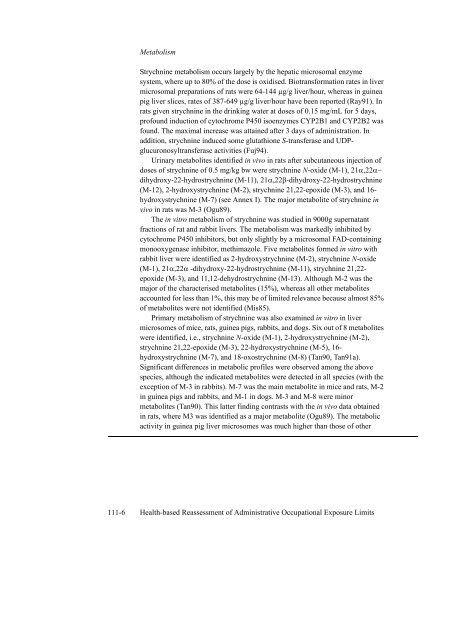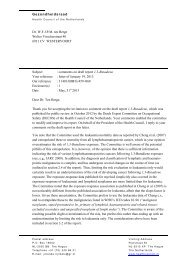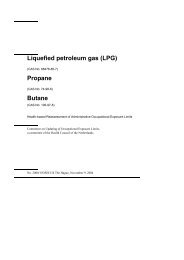Strychnine - Gezondheidsraad
Strychnine - Gezondheidsraad
Strychnine - Gezondheidsraad
You also want an ePaper? Increase the reach of your titles
YUMPU automatically turns print PDFs into web optimized ePapers that Google loves.
Metabolism<br />
<strong>Strychnine</strong> metabolism occurs largely by the hepatic microsomal enzyme<br />
system, where up to 80% of the dose is oxidised. Biotransformation rates in liver<br />
microsomal preparations of rats were 64-144 µg/g liver/hour, whereas in guinea<br />
pig liver slices, rates of 387-649 µg/g liver/hour have been reported (Ray91). In<br />
rats given strychnine in the drinking water at doses of 0.15 mg/mL for 5 days,<br />
profound induction of cytochrome P450 isoenzymes CYP2B1 and CYP2B2 was<br />
found. The maximal increase was attained after 3 days of administration. In<br />
addition, strychnine induced some glutathione S-transferase and UDPglucuronosyltransferase<br />
activities (Fuj94).<br />
Urinary metabolites identified in vivo in rats after subcutaneous injection of<br />
doses of strychnine of 0.5 mg/kg bw were strychnine N-oxide (M-1), 21α,22α−<br />
dihydroxy-22-hydrostrychnine (M-11), 21α,22β-dihydroxy-22-hydrostrychnine<br />
(M-12), 2-hydroxystrychnine (M-2), strychnine 21,22-epoxide (M-3), and 16-<br />
hydroxystrychnine (M-7) (see Annex I). The major metabolite of strychnine in<br />
vivo in rats was M-3 (Ogu89).<br />
The in vitro metabolism of strychnine was studied in 9000g supernatant<br />
fractions of rat and rabbit livers. The metabolism was markedly inhibited by<br />
cytochrome P450 inhibitors, but only slightly by a microsomal FAD-containing<br />
monooxygenase inhibitor, methimazole. Five metabolites formed in vitro with<br />
rabbit liver were identified as 2-hydroxystrychnine (M-2), strychnine N-oxide<br />
(M-1), 21α,22α -dihydroxy-22-hydrostrychnine (M-11), strychnine 21,22-<br />
epoxide (M-3), and 11,12-dehydrostrychnine (M-13). Although M-2 was the<br />
major of the characterised metabolites (15%), whereas all other metabolites<br />
accounted for less than 1%, this may be of limited relevance because almost 85%<br />
of metabolites were not identified (Mis85).<br />
Primary metabolism of strychnine was also examined in vitro in liver<br />
microsomes of mice, rats, guinea pigs, rabbits, and dogs. Six out of 8 metabolites<br />
were identified, i.e., strychnine N-oxide (M-1), 2-hydroxystrychnine (M-2),<br />
strychnine 21,22-epoxide (M-3), 22-hydroxystrychnine (M-5), 16-<br />
hydroxystrychnine (M-7), and 18-oxostrychnine (M-8) (Tan90, Tan91a).<br />
Significant differences in metabolic profiles were observed among the above<br />
species, although the indicated metabolites were detected in all species (with the<br />
exception of M-3 in rabbits). M-7 was the main metabolite in mice and rats, M-2<br />
in guinea pigs and rabbits, and M-1 in dogs. M-3 and M-8 were minor<br />
metabolites (Tan90). This latter finding contrasts with the in vivo data obtained<br />
in rats, where M3 was identified as a major metabolite (Ogu89). The metabolic<br />
activity in guinea pig liver microsomes was much higher than those of other<br />
111-6 Health-based Reassessment of Administrative Occupational Exposure Limits
















